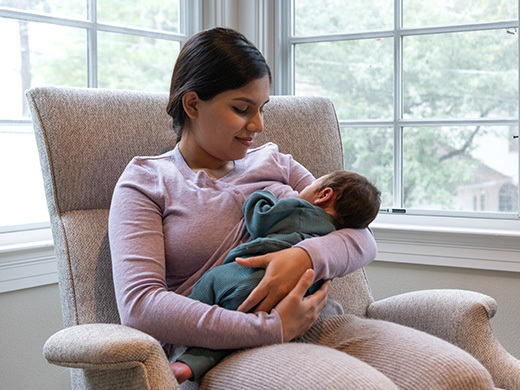Breastfeeding Support 24/7: 855-550-6667
SIMPLE, BUT POWERFUL
Skin-to-skin time is when baby snuggles on mom or dad's bare chest. Skin-to-skin is beneficial for all babies, whether they are breastfeeding or formula feeding.
The Benefits of Skin-to-Skin
Babies need lots of skin-to-skin time with mom and dad in the hospital and at home.
Skin-to-skin time:
- Calms you and your baby.
- Helps your baby cry less.
- Stabilizes your baby's temperature, breathing rate, heart rate and blood sugar.
- Helps your colostrum to flow more easily.
- Boosts your baby's immune system and helps protect against illnesses.
- Helps your baby gain weight faster.
- Lowers the chance of postpartum mood disorder.
- Gives you a chance to rest or take a break.
- Creates a connection between you and your baby that last a lifetime.
Getting Started with Skin-to-Skin
The first hour after delivery is often called the Sacred or Golden Hour. It is a special bonding time that begins when your baby is placed skin-to-skin on your chest right birth. Your heartbeat will calm your baby, and she will smell your breastmilk. Try to keep your baby skin-to-skin with no interruptions until she finishes her first feeding.
If your baby isn’t able to breastfeed in the first hour, ask for help with hand expressing your milk. This will help get your milk supply going even if your baby isn't able to suckle at your breast.
Plan for Skin-to-Skin in the Hospital
Make skin-to-skin part of your birth plan. Talk to your doctor and hospital to make sure they support skin-to-skin time.
- Ask your hospital if they offer skin-to-skin after cesarean section deliveries if you and your baby are alert and stable.
- Dad may want to wear a shirt that can be unbuttoned so he can easily snuggle your baby skin-to-skin.
- Let family and friends know about your plans. Tell them whenever you need privacy for skin-to-skin time in the hospital and at home.
- There is no specific age when skin-to-skin should stop. It provides powerful benefits for your baby throughout her first year.
Safe Skin-to-Skin
When you're having skin-to-skin time, you always want to make sure your baby can breathe. You don't want her chin tilted too far forward, and her nose and mouth should always be uncovered. Remember to:
- Save skin-to-skin for those times you won't fall asleep. If you fall asleep, you can easily block your baby's airway. You can ask your partner, parent or a nurse to watch over you and your baby if you are feeling tired.
- Keep your baby in an upright position.
- Make sure your baby's head is turned to the side with her nose up in a sniffing position so she can breathe easily.
- Dress your baby in a diaper and cap.
- Place a blanket over your baby's back to keep you both warm and cozy. Don't let the blankets cover her nose or mouth.




